Cichlazoma severum: varieties, tips for care and breeding
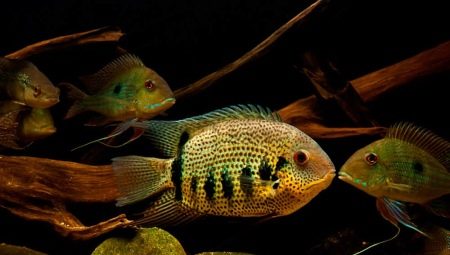
Many lovers of aquarium fish willingly give birth to severums. They are beautiful, bright, easily adaptable and do not suffer from a number of diseases that their less persistent brethren are prone to. In everyday life, a name such as false discussince the severum really looks like this fish. Find out more about the features, varieties and rules of keeping these graceful and beautiful inhabitants of the aquariums from our article.
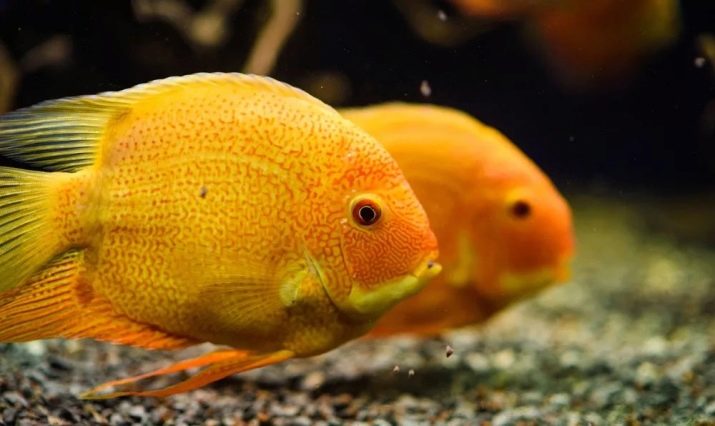
Description
Cichlazoma severum belongs to the cichlid family. It pleases the eye with its elegance and variety of colors. Usually, bird markets do not sell original severums, which are found in their natural habitat, but selection forms, each of which has its own name. In addition, after innovations in the classification, they began to be attributed to another genus - Heros. Nevertheless, out of habit, they are considered representatives of the genus Cichlasoma and have retained their familiar name.
Severum translates from Latin as "north" or "harsh", and Heros - as "hero". It is believed that they were nicknamed the northern ones due to the fact that they were caught farther north than other fish.

These fish attracted human attention in the 19th century, then they began to be caught in the basins of the Amazon, Rio Negro and Colombia rivers. They are distinguished by rather impressive heads and a flattened body. In aquariums, severums can reach a length of 20 cm, and in the wild, in the waters of hot countries, there are also thirty-centimeter specimens.
Severums differ from their relatives Discus cichlids in color and size.Cyclamosis severum at home does not grow more than 20 cm, while Discus may be 10 cm longer. As for the color, the severum has a greenish-golden belly, and in juveniles, moreover, there are usually eight black vertical stripes on the body. Because of this it is also called convict fish, deacon, striped cichlid. Another variant of the name of the severum is calm cichlid.
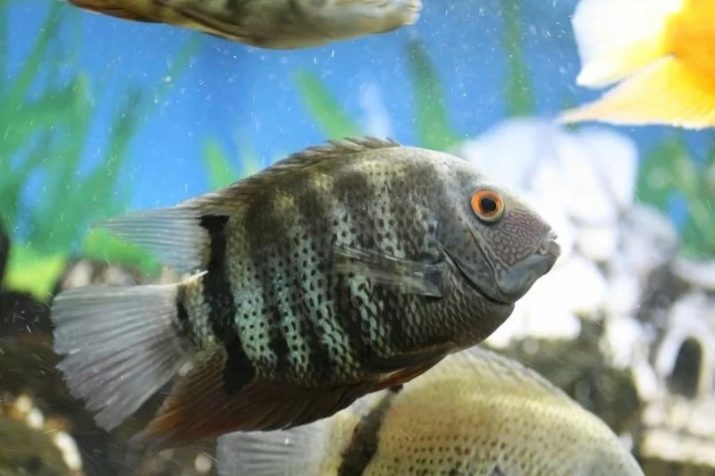
Sex determination
Even the seasoned aquarist can be difficult to identify by gender. These differences are so fragile that even the fish themselves can get confused in this matter. For example, sometimes there are cases when two females form a pair, spawn, but it remains unfertilized. And yet there are a number of signs that help distinguish the male from the female:
- the anal and dorsal fins in boys are more pointed;
- the color of the males is more saturated;
- the forehead in females has a more convex shape;
- the boy's gills are partially decorated with dark pigment;
- females are marked with a dark spot on the dorsal fin.
It is easier to differentiate fish by sex at a young age; over time, their already insignificant differences become even less obvious.
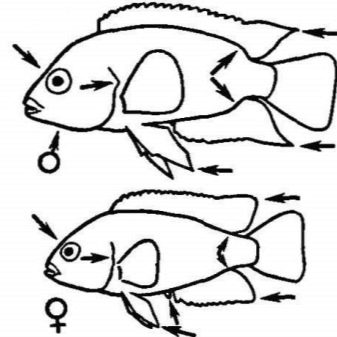
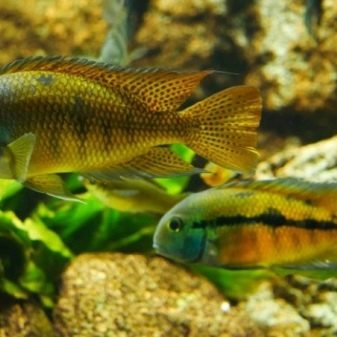
Views
In the course of selection, a huge number of severum species appeared, which differ from their progenitor in that they are more suitable for home keeping. Let's consider the most popular and beautiful ones.
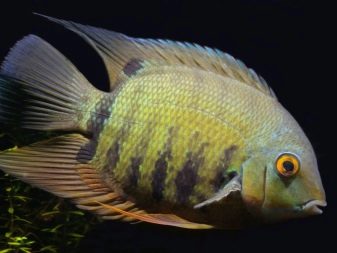
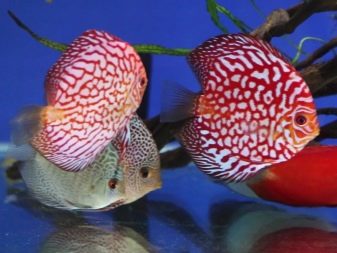
Severum red pearl
This red-dotted severum has a very nice looking color. Its body is colored yellow, while it is decorated with red specks that resemble pearls.
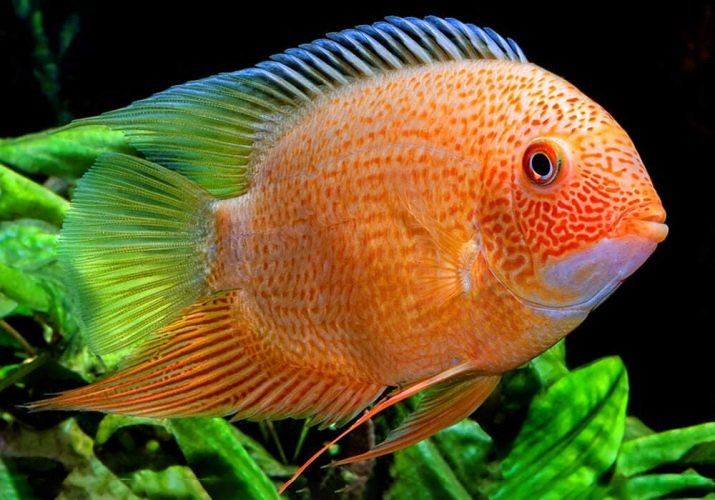
Severum Gold
One of the colored species, devoid of the black stripes common to most severum colors. The body of the fish is colored yellow, and the tail and fin on the back have a lighter tone with yellow spots, which makes them look like gold.
This color looks quite attractive, due to which the severum of this subspecies is in great demand among buyers.

Red-shouldered severum rothkeil
The color of these individuals can range from olive to silver with dark spots. Its main feature is orange fins and a bright stripe of the same color in the head area. Quite an original color makes them outstanding representatives of the genus.
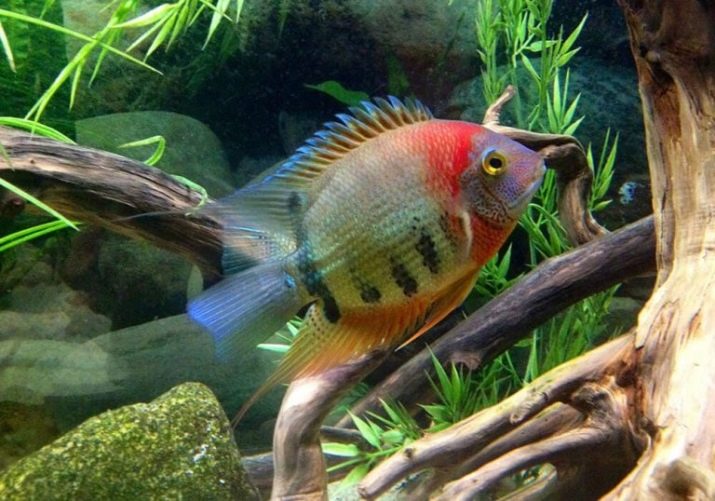
Gayansky Severum
His middle name is green severum. This is the color of its scales, which are decorated with dark spots. It is distinguished by a graceful body shape, juveniles are also covered with vertical stripes, but with age they become indistinguishable.
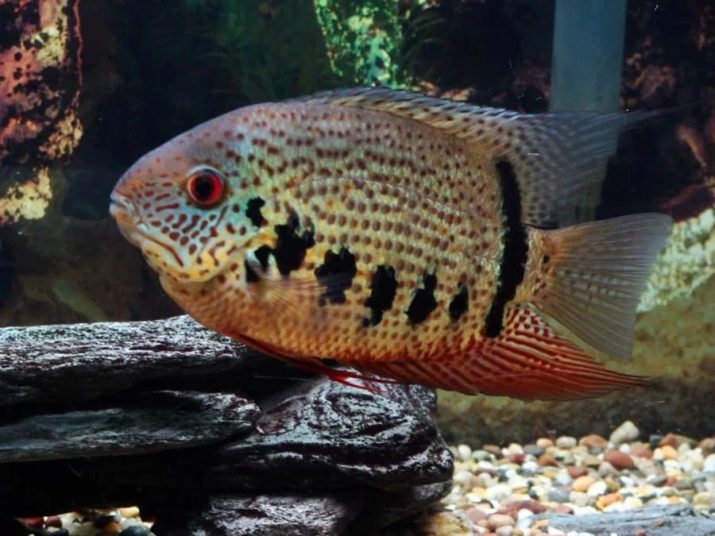
Severum moutbrider
For his cute scarlet tummy, he is also called red-bellied. Over time, a black stripe appears more and more in the caudal fin zone.
An interesting feature of this fish is that it carries offspring in the mouth.
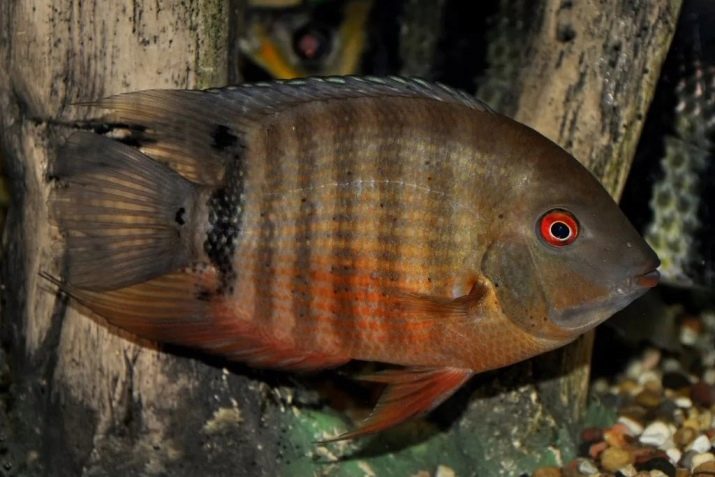
Severum santarem
The beautiful "blue emerald" aquamir is in great demand among breeders. The beautiful emerald blue color captivates both amateurs and professionals in the aquarium hobby. Typical for severum, the dark stripes located on the sides change shape with age and become like spots.
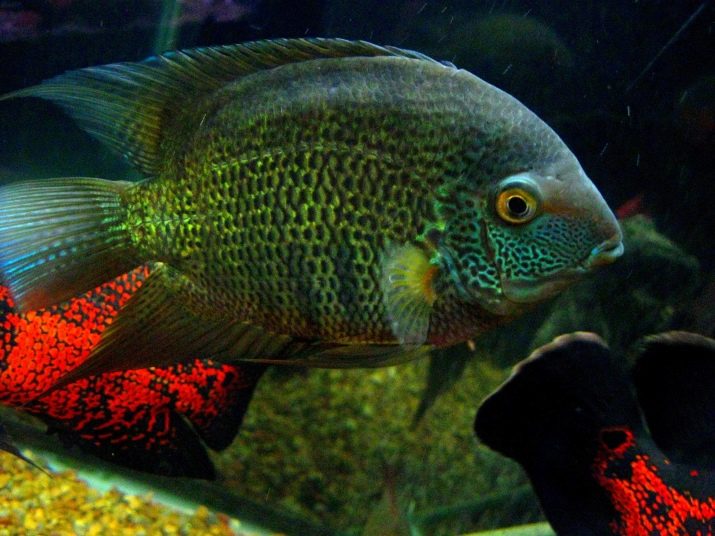
Severum inirida
The Severum Inirida fish also has quite an interesting coloration, which makes it a desirable specimen for the aquarist. Its dark body is adorned with iridescent silvery spots. From a distance, they can resemble stripes running along the sides from the abdomen to the back.

Features of the content
It is not difficult for this fish to withstand temperature fluctuations in the aquarium, if they are within acceptable limits. In addition, it is resistant to many fish diseases. The only thing that is important for these beautiful fish is a rather spacious "house", that is, an aquarium. It has been noticed that their build may depend on the vessel in which they live. So, in aquariums with high walls, these fish begin to swell in breadth, which makes them similar to discus, and in narrow ones, on the contrary, they increase in length.
Severums love to pull algae and even pluck them up by the roots, thereby devaluing all the efforts of the owner to improve the aquarium. Vegetation with strong roots is best suited for them. In such cases, it is recommended to plant more representatives of the aquarium flora, such as Cryptocoryne, Vallisneria, which quickly grow in length. So that they "sit" quite tightly, they need to be rooted with great care, further strengthening the adhesion with large pebbles.

Clean water contributes to the normal state of its inhabitants, and an aesthetically transparent aquarium looks much better than a cloudy one. Despite the fact that the fish themselves love stagnant water, it still needs to be cleaned and oxygenated. Every week, you need to replace a fifth of the aquarium water volume with clean water. As for lighting, in this respect, fish are undemanding - they are quite suitable for the usual light mode for a home pond.
Severums love to eat a variety of foods. Both live food in frozen form and dry are suitable for them. An inexpensive plant duckweed is quite suitable to meet their need for plant foods. Also, these fish will not refuse feeding in the form of scalded lettuce or spinach.
In general, the diet for these cichlids is the same as for most aquarium dwellers.

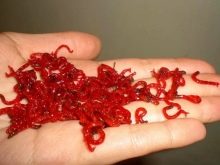
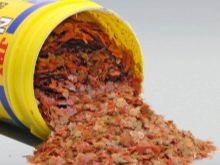
Compatibility with other fish
To join these pets, you need to choose fish of similar size. Too small individuals will be perceived by severum as food. This also applies to everyone's favorite guppies, neons and tetras. In doing so, keep in mind that American varieties of cichlids are softer in character than African ones, but they can also wake up predatory habits - not very small, but sluggish aquatic organisms can be persecuted. The severums will show respect to large neighbors and behave calmly with them.
They can really be called pets, as they recognize their owner and can "communicate" with him through the glass. When he appears, they move more animatedly, thereby showing their interest, and look towards the person. At the same time, they do not show such warmth in communication with strangers, and sometimes they behave wary with them. Having seen an aquarium with these handsome men at a party, it is better to admire them from a distance - you should not test their patience.
If a stranger tries to bring his hand to the water, then the severums may try to bite it.
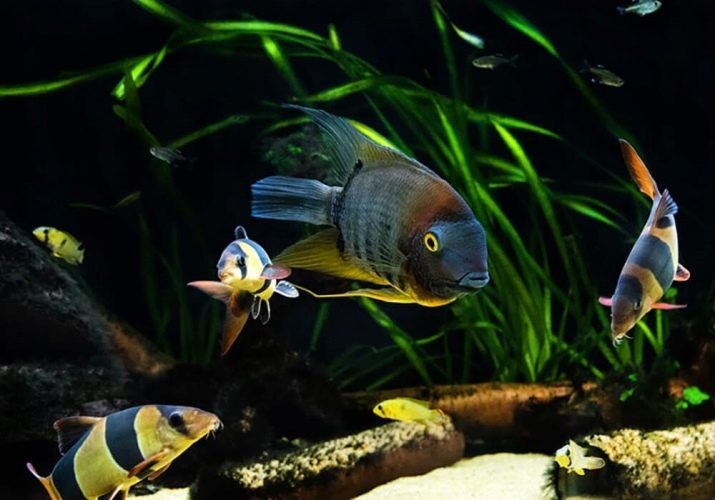
Breeding
It is always nice to get offspring from your favorite fish, and if you are seriously thinking about selling severums, then you should know all the intricacies of the process of breeding them.
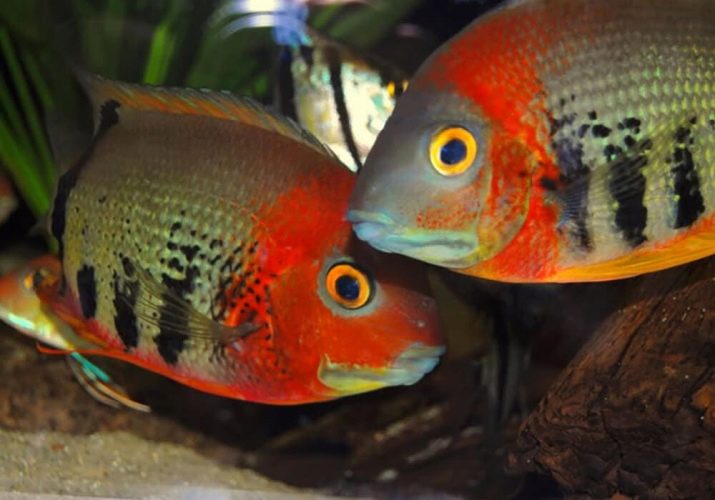
Pairing
To have a couple that will bring offspring, you need to purchase a flock of severums. If the sex of the fish is known, then it is enough to buy one male and three or four females. When individuals enter the ripening season, they will choose their own partners. The choice is needed so that the boy selects an individual not from his clutch. It is difficult to say exactly how he makes a choice, but this approach allows him to get healthy offspring.
After the "family" is successfully formed, then all the other neighbors in the flock will have to be evicted from the aquarium so that the fish do not begin to show aggression towards each other. They can be transferred to another tank, donated to someone, or you can try to sell them. If you initially want to get a couple of producers that will multiply, then buy a ready-made one - this will avoid unnecessary problems.
The best spawning age for this breed is one and a half years. If the fish want to start breeding earlier, then they are unlikely to be able to produce viable eggs.
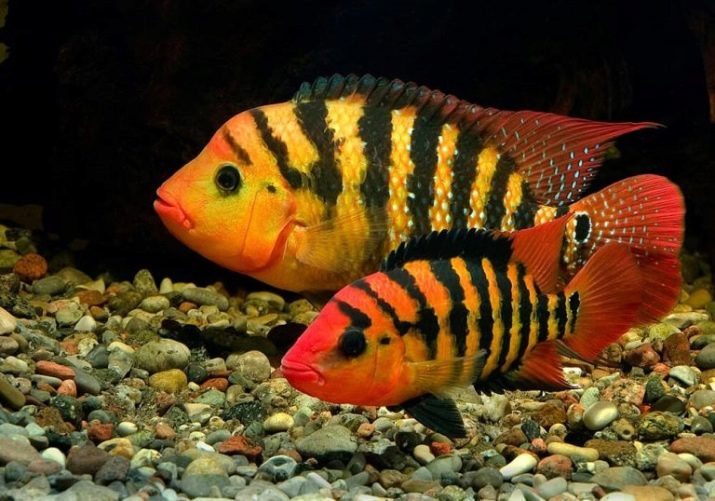
It is possible to determine that the male and female have found each other and are ready to start giving birth as follows: they began to swim together, to observe the boundaries of their territory, in addition, the cichlid shows possessive feelings towards the soulmate (trying to close her body from her relatives).To encourage fish to breed, create a comfortable environment for them. Best for them water with acidity at pH 7 and hardness no higher than 15.
Spawning
Before the female lays eggs, she and the male participate in the so-called love games - the fish begin to swim, describing circles in the water. Sometimes they whirl in a "kiss" - their mouths locked together. When the female spawns, it is fertilized by the male. Further, the family's tasks include taking care of the offspring - they carefully monitor the safety of the clutch until the fry hatch.

Fry care
Babies hatch from eggs about a week after spawning. At first, they hardly move around the aquarium, feeding on what is in the gall sac. When the nutrient supply comes to an end, they have no choice but to begin to get food on their own. More precisely, there is something that a caring owner will fill them with. This is how they begin to grow up, and gradually small fish grow to the standard size of their species.
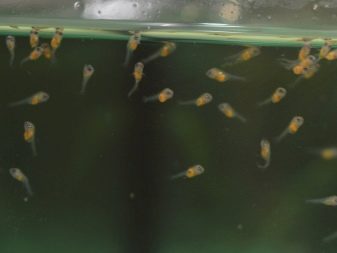
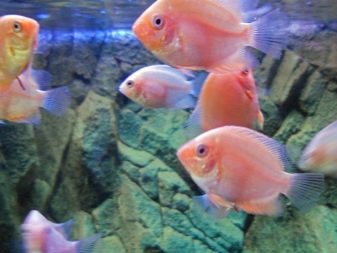
Summing up, we note that Severums are one of the brightest representatives of the aquarium world. Their variety of colors makes them popular with both hobbyists and professional breeders.
When settling them with other fish, remember about the predatory nature of these cichlids and do not create dangerous situations - the neighborhood with smaller or slower fish can be perceived for severums as an excuse to hunt them. At the same time, they are not indifferent to their master and exchange glances with him with great interest, demonstrating affection.
Keeping them at home does not create any particular difficulties, so severums can become a desirable acquisition for any aquarist.
You will learn more about this fish species from the video below.








